


LINEAGE, E51 and SPENCER KAROL
The unit represented by our E51 G75 LRRP/Ranger Association has had a distinguished history. The post-WWII history of the unit began when it was formed in December ’66 and January ’67 as the LRRP Detachment of the 196th Light Infantry Brigade (the “196thLIB”), headquartered in Tay Ninh, Vietnam. Later in 1967, as the 196thLIB became part of Task Force Oregon, along with the 1st Brigade, 101st Airborne, and the 3rd Brigade, 25th Infantry Division (the latter later redesignated the 3rd Brigade, 4th Infantry Division), the 196thLIB LRRP unit was reconstituted as E Co. (Long Range Patrol), 51st Infantry Regiment and eventually as G Co. (Ranger), 75th Infantry Regiment, both of the Americal (23rd Infantry) Division. During the period during which the unit was active in Vietnam, the longest period of its dedicated service to the Nation was during its designation as E51. The unit has thus far produced two members of the US Army Ranger Hall of Fame from the Vietnam era – Robert Pruden (who was posthumously awarded the Medal of Honor) and Vic Valeriano. The unit left a remarkable legacy for those who followed. And so, it is with immense pride and a sense of familial continuity then that our membership can look to the work being done not only by the men and officers of the 75th Ranger Regiment, but also to the men and officers of E Co. (LRCS), 51st Infantry (ABN) now serving in Iraq, and their many contributions to our Nation's global war against terrorism.
The inclusion of the new
E51 LRS unit on the G Co. portion of the 75th Ranger Regiment
Association website is intended to recognize the fact that E51 LRS is
historically linked to our 196th LRRP, E51, G75 Ranger unit by proper
military lineage – lineage reflecting the similarities of missions, SOPs, etc.,
and which has been recognized by the US Army. The men of the E51 LRS unit have
embraced the veterans of our Vietnam-era unit in an extremely positive way that
speaks to the importance of continuity and tradition in the military. And the
veterans of our E51 G75 Association clearly have a brotherly attachment to the
men of the current E51 LRS. The men of the current E51 LRS continue to honor
their predecessors by wearing bracelets bearing the names of our own honored
dead - see the story entitled "Embracing Memories" by Sgt. Kain Horn and Spc.
Jeff Balduini, both formerly of E51 LRS under "Feature Article" on our E51 G75
website -
www.lrrpranger.org . The young warriors from E51 LRS named their annual
competition and several of their base installations after Robert Pruden (MOH,
Ranger HOF), a legendary veteran of our unit. Veterans of our Association have
visited with E51 LRS in Europe. It is not just that they bear the same unit
designation as we did. It goes further than that. At our reunion in San Diego
several years ago, the former CO of the new E51 LRS – Scott Nelson - spoke to
our group, and made it clear that their current mission is the same basic
mission as we undertook in Vietnam, and that the same spirit and commitment to
the ideals exemplified by the Ranger community flow in a direct line from the
men of the 196th LRRPs, E51, and G75 to the young men of E51 LRS.
In the current war on terrorism being waged by our Nation, E51 LRS is carrying a heavy load. E51 has been active in the Balkans – in Kosovo and Bosnia – where the unit played a major role in locating Slobodan Milosevic. Since action commenced in Iraq (and even before that) E51 LRS, attached to the 165th Military Intelligence Battalion, was on the ground. Its first missions in Iraq are reported in some detail in “On Point” – see http://www.globalsecurity.org/military/library/report/2004/onpoint/ch-4.htm. And, since the run up to Baghdad, the unit has seen action on the borders of Iran, Syria and Saudi Arabia, and has run countless ambushes and local recons in support of the 3rd Armored Cavalry Regiment (the “3rdACR”), the 3rd Infantry Division (the “3rdID”), and the 4th Infantry Division (the “4thID”). To provide an idea of what the unit is doing, I’ve included below, an excerpt from an email that we received from Sgt. Travis Prohaska, formerly the Team Leader of E51’s team 1-6, in his own words, describing the team’s actions during the run up to Baghdad.
“I am not sure exactly what you want to know about, but I will write a little bit about the first missions that went into enemy territory. I am not going to tell you about the other team missions because I was not there and everything thing I know about them is hearsay.
Before the war started, my team was one of 36 LRS teams. F Co. 51st from 18th
Airborne LRS was attached to 165th (Military Intelligence Battalion)
because 5th Corps was overall in charge, I believe. That is above my head in the
politics. Out of our teams, there were three teams selected. SSG Barnwell’s, SSG
Armstrong’s, and my team were selected to pull surveillance on the first three
“NAIs” (Named Area of Interest) into enemy territory. All three teams’ areas
were in the same area of Iraq. The NAIs were about 350 km into enemy territory.
We planned for the mission for three days as practice because we were not sure
when the war was going to start. Once we found out the war was going to start we
went back into planning and planned for another 24 hours. We planned to stay out
for five days, but it all depended on the rate that 3ID was moving. We had two
CH-47 Chinook helicopters for the three teams. SSG Barnwell and Armstrong’s team
were on one and my team was on the other. My team inserted about 7 kms from our
tentative hide site. Once we were off the aircraft we pulled “SLLS” (stop, look,
listen, smell) and then proceeded on azimuth to our tentative hide site. In
route we ran into dogs. We were following a small ditch. The dogs followed us
all most all the way to our hide site. Each man’s rucksack weighed at least 125
pounds so the moving was slow, but we tried to pick up the pace because we were
a little behind schedule, since the aircraft had to take off late due to
mechanical problems. Once we made it to our hide site we started digging in. We
were able to develop a good plan on where to set our hide site because our
operations sergeant - SFC Freeborg - was able to give us line of site imagery
which showed us where we could set our hide site and see the objective with no
problems. The usual hide site is about two and a half feet deep. Because of the
rocky soil we were only able to get about one and a half feet down in only a few
places. The site was completed right about sunrise. As soon as we were in the
site SPC Rieman looked at me and told me we had enemy. None of us could believe
it because this was our first mission and it was something that you only dream
about (to do your job in combat). All day we had a lot of enemy activity. We had
problems relaying this information back to the unit HQ because the HF (high
frequency) was not working and the SATCOM (satellite communication) channel was
so busy that we were unable to get anything through. We did contact the Air
Force and asked them to relay to our unit that we were having communication
problems, but the mission was still a go. Throughout the day we had a few
farmers come near our site. One farmer’s sheep came right up to our site. We
were worried that the sheep were going to step on the site and collapse it since
it was only made of PVC piping with a bed sheet spread over the top. That night
we had enemy soldiers come within 100m of the site many times and a few times
the enemy came with in 1 or 2 meters of the site. I know that 100 meters does
not sound close to the men who served in Vietnam, but the desert is a much
different environment. Throughout the night enemy soldiers on foot and in
civilian vehicles circled all around our site. Late that night, and early
morning we heard a few gunshots off in the distance. When the sun came up we saw
around 60 enemy loading into seven trucks preparing to head south to attack 3rd
ID. We still did not have communication with our HQ so we sent this information
up through the Air Force located at the Corps HQ. The information was dispersed
and within a few minutes aircraft were bombing the area. The 3rd ID pushed
forward and engaged in about 8 to 10 hour firefight one to two kilometers south
of our position. Once 3rd ID had the situation under control and they moved
through our area, E51’s LNO that drove with 3rd ID from Kuwait led by CPT Kapla
came up to our site and picked us up. After we were picked up, we drove a few
miles south to an area to wait for aircraft to fly us back to Kuwait. While we
were waiting I had the privilege to talk to a few of the men from 3rd ID. They
told me that the information that we sent up saved lives. Because of that
information 3ID changed their movement formation and put the tanks and Bradley’s
up front instead of the light skinned HMMWV.
I trusted the men in my team 100 percent
before the mission. The team had worked together for about one and half years
before the war with the exception of one, who only worked with the team for
about six months before the war.
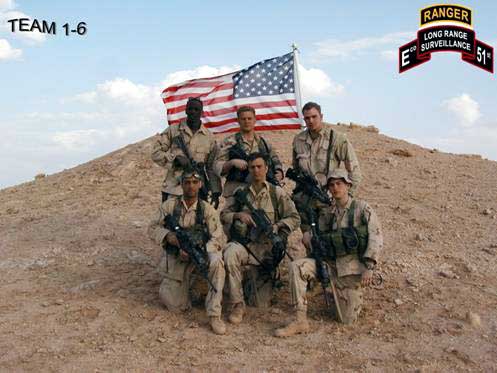
Team 1-6
left to right, kneeling: ARTO- Pfc. Robert McAllister; RTO- Spc. William Decker; SSO- Sgt. Anthony McGlone;
left to right, standing: ATL- Sgt. David Solomon; SO- Spc. Jeffery Rieman; TL- Ssg. Travis Prohaska.
Even though I am now in Florida with 6th Ranger Training Brigade and not with
E51, I still try and keep in contact with my team. SSG Solomon is still with E51
and is now a team leader. SGT McGlone is with the10th Mountain Division. He also
served a few months in Afghanistan after his time in Iraq. SGT Rieman after
being hospitalized for gunshot and shrapnel wounds is now in the 82nd. SPC
Decker is now with 101st and is planning on coming through Ranger school soon.
SPC McAllister is still with E51 and will get out of the army in a few months
and go back to work with his father in Massachusetts.
Thanks!
Rangers Lead The Way,
Travis Prohaska”
But where there is great courage, valor, and gallantry, there is sometimes great sorrow and great loss. The deep and meaningful expression “freedom is not free” is in danger of becoming overused by well-meaning reporters. But for those families and friends of the dedicated Armed Forces who have sacrificed their lives serving our Nation in Afghanistan and Iraq, the meaning is, sadly, all too clear. One of those who lost his life was Spc. Spencer T. Karol, and his death is a loss, not only to his family, but also to his extended E51 family. Spencer Karol died on October 6, 2003. He was 20 years old and hailed from Woodruff, Arizona. He had attended nearby Holbrook High School. He leaves his parents and several brothers. He was planning to be married and leaves a fiancée. Spc. Karol was one of the young patriots and warriors in E51 LRS. He was a member of Team 2-1 led by Ssg. Dominik Kepa.
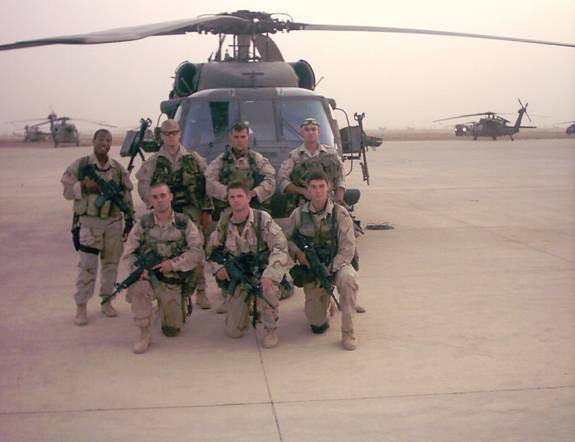
Team 2-1 (photo taken several months prior to 10/6/03)
left to right, kneeling: Spc. Nicolas Williams; Pfc. Michael Records; Spc. Spencer Karol
left to right, standing: Sfc. Jay Carter; Spc. Sean Kinney; Sfc. Todd Galliand; Ssg. Dominik Kepa.
Spencer Karol was killed doing the job for which he was trained and the job he wanted to do. He developed a reputation for accepting the toughest missions in a platoon that routinely made enemy contact. On October 6, 2003, Spc. Karol’s team was asked to take on a clandestine insertion in the vicinity of Hit, Iraq, in a civilian vehicle – a white SUV. The members of the 5-man Team 2-1 on October 6 were: Ssg. Dominik Kepa (TL); Pfc. Michael Records; Spc. Diehn; Sgt. Nickolas Williams (ATL); and Spc. Spencer Karol. Though the team was tired from a lengthy return trip from near the Syrian border, the team agreed, as Ssg. Kepa put it, “you can never be too tired to take out more garbage.” The objective that night was to infiltrate an abandoned compound adjacent to a frequently used convoy route outside Hit, setting up an observation/listening post, and destroying any enemy elements attempting to place “IEDs” (improvised explosive devices) on the convoy route before breaking contact and calling in Predator elements from the 3rdACR to finish the job, if necessary. The abandoned compound selected had been used by another team some time before. Sgt. Williams drove the vehicle, and Ssg. Kepa rode shotgun. Spc. Records and Spc. Diehn rode in the back seat, with Spc. Karol providing rear security in the back, carrying his M-249. Unknown to the team, the road leading to and from the compound was mined with IEDs , and one was detonated as the team’s vehicle passed over it. The vehicle hit the IED which capsized the vehicle. Spc. Karol was thrown from the vehicle and killed. Three other members of the team were also injured – Sgt. Williams had a large wound on his left arm (although he was subsequently able to carry Spc. Diehn); Spc. Diehn had his back broken in three places; and Spc. Records was severely wounded in the back and legs. The team’s communication equipment was destroyed in the blast, and the team was unable to contact its “QRF” (quick reaction force). Most of the team’s weapons had also been destroyed, even their small arms. Ssg. Kepa collected and secured the team, the wounded, and Spc. Karol’s body. He then proceeded to commandeer a civilian vehicle – a white pickup truck. Ssg. Kepa carried the body of Spc. Karol and Sgt. Williams carried Spc. Diehn to the truck. Spc. Records was able to move under his own power. They then loaded the truck, and began the over one-hour trip back to the base. Ssg. Kepa realized that the team, having left a friendly position in a white SUV, only to return in a different vehicle without working communication equipment, would not simply be able to drive up to the gates of the base without challenge or even potential fire from the base. He stopped well short of the gate and walked without weapons from the vehicle to the gate to identify his team. Later, when QRF elements from the 3rdACR secured the site of the explosion, they found a stockpile of explosives intended to be used in other IEDs. They were able to ascertain that the IED that was used to destroy Team 2-1’s vehicle was likely to have been two stacked anti-tank mines.
Spencer Karol represented an important link over the bridge of 35 years or so of military history from our unit to theirs, as well as an ideal of service to the nation and volunteerism that the members of our unit cherish, as does the service of all the men and officers of E51. Through his commitment to his team; the fact that he took on his team’s toughest tasks; and by wearing the E51 “colors”, Spc. Karol honored the traditions of our unit in Vietnam. He was posthumously awarded the Bronze Star and the Purple Heart for his actions during the encounter. Spc. Karol’s teammates who were also badly injured in the explosion that took Spc. Karol’s life will recover from their wounds.
|
|
Specialist Spencer T. Karol
13 April 1983 – 6 October 2003
On December 10, 2003, another 3 men of E51 were caught in an ambush triggered by another IED. One lost his leg, another took shrapnel to his face, and the last took three shots to the chest. All will survive. The man who lost his leg told his CO – Capt. Patrick Grow - “I’m glad it was me, and not one of the married guys.”
Just through last October, E51 had had 10 wounded in action.
What with writing articles for “Patrolling,” as well as our unit Association’s own newsletter – “Sua Sponte - it’s at times difficult to come up with a subject to write about, or to find the time. This time it was easy. The men of E51 are doing the heavy lifting, and their story deserves to be told.
GOD WATCH OVER OUR ARMED FORCES, THE MEN AND OFFICERS OF THE 75TH RANGER REGIMENT, THE MEN AND OFFICERS OF E51 LRS, AND ESPECIALLY, MAY GOD BLESS SPENCER T. KAROL.
Thanks to all who helped me gather info for this piece – particularly Capt. Patrick Grow, Ssg. Dominik Kepa, and Ssg. Travis Prohaska for their help, and for providing me with their insights. Thanks to Ssg. Dominik Kepa for the photos.
TOM NASH
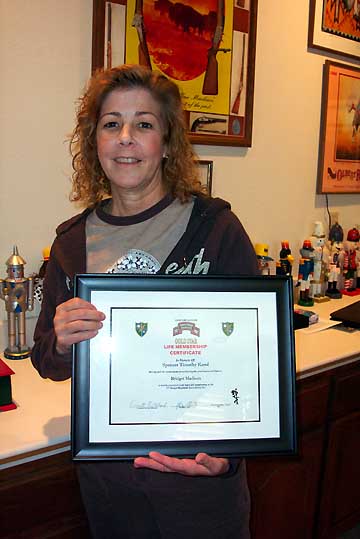
Bridget Madison displaying her Gold Star Mother's Plaque
honoring her son, Spencer Timothy Karol KIA 6 Oct 2003
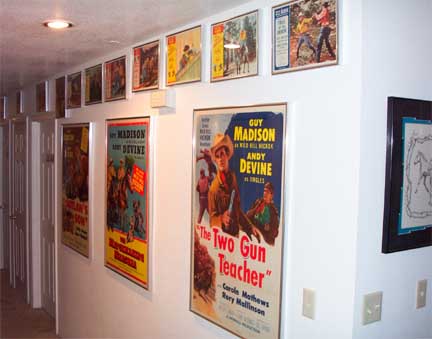
The walls of Ms. Madison's home are lines with tributes to her late father, Guy
Madison,
best known for playing Wild Bill Hickok in 1950's Hollywood westerns.
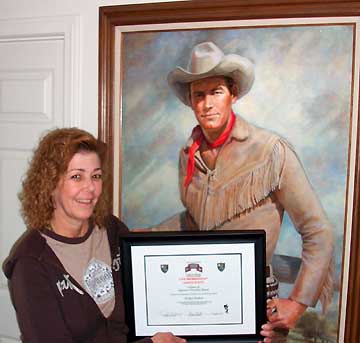
Bridget Madison displaying her Gold Star Mother's Plaque
in front of an oil painting of her actor father.